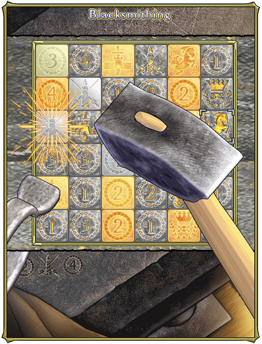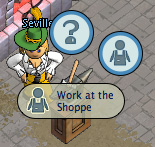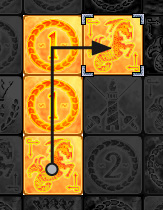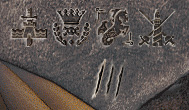Official:Blacksmithing
Contents
Blacksmithing
Introduction
Blacksmithing is the ancient art of working metal to make swords, armor, and (for the land lubbers out there) a plough or two. A pirate can take blacksmithing work at the Iron Mongers.
Working the blacksmithing puzzle takes skill and planning. The goal of the puzzle is to clear all of the squares on the board by striking each one three times. However, the pattern on each square governs which squares may be struck next. It takes planning and forethought to complete the board without first running into a position where no further moves are legal.
Scoring is based on how much of the board you clear and, as importantly, the style and skill shown in picking the sequences of squares you strike.
Blacksmithing Basics
Forge the sword by hammering the squares until they are fully cooled. The type of square you strike determines which squares you may strike next. Each strike cools the square slightly from its initial red hot to a warm grey then to a cool silver. If it is struck a third time, it will disappear entirely and can no longer be struck.
Once a piece has been struck, each square which can be struck next will glow. The number and placement of the pieces that can be struck next are determined by the pattern on the piece you choose (so pick carefully!). Since each piece struck limits the options for which squares may be struck next, you may find that you have no options remaining. You score is partly determined by the total number of pieces you are able to clear during a game.
The rules governing the sequence of pieces you may strike are explained below.
Controls
You can control the Blacksmithing puzzle with either your mouse or the keyboard:
- Mouse Movement: Move Cursor
- Left Mouse Button: Strike Piece
On the keyboard:
- Arrow Keys: Move Cursor
- Space: Strike Piece
The Basic and Chess Pieces
Each piece on the board has an icon that determines the move it will allow once you strike it:
The basic pieces have number icons. The number on these pieces requires that the following move be exactly that number of squares away from your current piece, vertically, horizontally, or diagonally.
In addition to the numeric pieces on the board, some squares will be filled with chess piece icons. Striking one of these pieces limits your next move in a way similar to the move options available in a game of chess:
- Rooks must be followed by striking a piece at the edge of the board and in line with the rook vertically or horizontally.
- Bishops must be followed by striking a piece at the edge of the board and diagonally in line with the bishop.
- Knights must be followed by striking a piece two squares in one direction and one square perpendicular to that direction.
The image above is an example of the simple "L" shape move for a knight piece.
Fours and Queens
- Fours must be followed by striking a piece four squares from its position.
- Queens have great flexibility and may be followed by striking a piece at the edge of the board and horizontally, vertically, or diagonally in line with the queen.
Rum Jugs
Rum jugs are wild! Ye may strike any square on the board following striking a rum jug.
Ye will be awarded a rum jug piece once ye have struck each square on the board once and again once ye have struck each square on the board twice.
Matching Sets
The more of the same type of square ye can strike in a row, the more points ye will earn. Yer recent strikes are indicated just below the board.
If ye strike all of the different numeric or all of the different chess types in sequence, this will form a set, which will earn ye bonus points as well.
Sequence Sets
The sequence in which ye hit tokens can create "numeric sets" or "chess sets":
- Numeric Sets are created by hitting each different numbered piece (1,2,3,4) in sequence. To create a numeric set, it is not necessary to hit each number consecutively, as shown in the example below.
- Chess Sets are created by hitting each different chess piece (knight, rook, bishop, queen) in sequence. To create a chess set, you can hit the chess pieces in any order as long as you do not hit the same piece twice.
Chaining Sets
If ye complete a set of numeric pieces immediately after completing a set of chess pieces (or vice versa), ye receive a bonus for chaining these together. Following this with another set of numeric pieces will continue the chain. The longer yer chain, the more points can be earned.
Edges & Corners
Where a piece sits on the board can have a significant effect on when you might best hit it. Certain types of pieces may have more options when near the middle, near an edge, or near the corner. Try to take these differences in flexibility into account when deciding which squares to strike and which to leave for later.
Masterpieces
Only the expert smiths can forge masterpiece swords. If ye can clear the entire board, ye will receive bonus points for the feat. If ye get close but can't quite complete the board, ye will still receive a partial bonus.
Even if ye can't complete the sword, yer still awarded points for sets and repeated pieces struck as yer going, so yer efforts will not be for naught!












